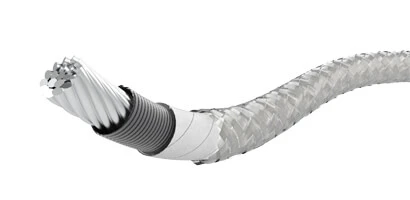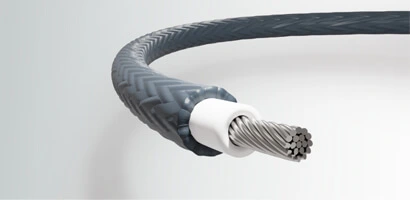250°C Ultra-High Temperature Wire and Cables are engineered to withstand extreme heat environments, offering reliable performance in industrial applications. With advanced insulation materials, they ensure safety and durability, meeting stringent industry standards.

Operating Temperature: +250 °C
Operating Voltage: 600V
Insulation: PTFE tape with glass serve
Approval: as per UL approvalex. as per standard UL 758 ex. RoHS Compliant

Operating Temperature: +250°C
Operating Voltage: 300V
Insulation: composites
Approval: UL/cUL (in progress)

Operating Temperature: +250°C
Operating Voltage: 600V
Insulation: composites
Approval: UL/cUL (in progress)

Operating Temperature: +250 °C
Operating Voltage: 600V
Insulation: PTFE tape with glass serve
Approval: as per UL approvalex. as per standard UL 758 ex. RoHS Compliant
1. Insulation Material Selection:
Thermoplastic vs. Thermoset:
Choose the appropriate insulation material based on the specific application requirements. Thermoplastic materials like fluoropolymers (e.g., PTFE, FEP, PFA) and silicone rubber offer excellent heat resistance and flexibility. Thermoset materials such as cross-linked polyethylene (XLPE) are also suitable for high-temperature applications.
Heat Resistance and Stability:
Select insulation materials capable of withstanding continuous operating temperatures up to 250°C without degradation or loss of mechanical properties.
Chemical Compatibility:
Ensure the insulation material is resistant to chemicals, oils, solvents, and other substances commonly encountered in industrial environments.
2. Conductor Material and Configuration:
High-Temperature Conductors:
Use conductive materials like nickel-plated copper or other high-temperature alloys that can maintain electrical conductivity and mechanical strength at elevated temperatures.
Stranding and Flexibility:
Optimize conductor stranding and flexibility to withstand mechanical stress and bending without compromising electrical performance.
3. Insulation Thickness and Performance:
Optimal Insulation Thickness:
Determine the appropriate insulation thickness to provide sufficient electrical insulation and thermal protection while maintaining flexibility and compactness.
Dielectric Strength:
Ensure the insulation material exhibits high dielectric strength to prevent electrical breakdown under high voltages.
4. Mechanical Durability:
Abrasion and Cut Resistance:
Incorporate protective layers or coatings to enhance resistance against abrasion, cutting, and mechanical damage, especially in rugged industrial environments.
Flexibility and Bend Radius:
Design wires with sufficient flexibility and bend radius to facilitate installation and routing in tight spaces without causing insulation damage.
5. Environmental Considerations:
Moisture and Chemical Resistance:
Choose insulation materials that offer excellent resistance to moisture, humidity, and chemical exposure to ensure long-term performance and reliability.
UV and Weather Resistance:
If used outdoors, ensure the wire's insulation is UV-resistant and capable of withstanding environmental factors such as sunlight, rain, and temperature fluctuations.
6. Electrical Performance:
Low Signal Loss and Impedance:
Minimize signal loss and impedance by selecting insulation materials with low dissipation factor and maintaining consistent electrical properties at high temperatures.
Signal Integrity:
Ensure reliable signal transmission and electrical performance under extreme heat conditions to meet specific application requirements.
7. Compliance and Standards:
Regulatory Compliance:
Design wires in accordance with industry standards and safety regulations (e.g., UL, CSA) for electrical insulation, flame resistance, and environmental protection.
8. Testing and Validation:
Performance Testing:
Conduct rigorous testing (e.g., thermal cycling, mechanical stress tests, electrical performance tests) to validate the wire's performance and reliability under simulated operating conditions.
Selection of High-Temperature Insulation Materials:
Identifying and sourcing insulation materials capable of withstanding continuous temperatures up to 250°C without degradation or loss of electrical properties.
Thermal Stability of Insulation:
Ensuring insulation materials maintain their mechanical and electrical properties under prolonged exposure to high temperatures, thermal cycling, and thermal shock.
Compatibility with Manufacturing Processes:
Adapting manufacturing processes such as extrusion, curing, and coating to handle high-temperature insulation materials without causing material degradation or processing issues.
Mechanical Strength and Flexibility:
Achieving optimal balance between mechanical strength and flexibility to withstand mechanical stress, bending, and installation requirements without compromising insulation integrity.
Chemical Resistance and Environmental Factors:
Addressing challenges related to chemical exposure, moisture ingress, UV radiation, and other environmental factors that can affect wire performance and longevity.
Precision in Conductor Manufacturing:
Ensuring precision in conductor manufacturing processes to achieve uniformity, conductivity, and resistance properties required for high-temperature applications.
Compliance with Safety Standards:
Meeting stringent safety and regulatory standards (e.g., UL, CSA) for electrical insulation, flame resistance, and environmental protection.
Advanced Insulation Materials:
Development of specialized insulation materials such as fluoropolymers (e.g., PTFE, FEP, PFA), silicone rubbers, and ceramic fibers with enhanced thermal stability and chemical resistance.
Nano-coatings and Additives:
Integration of nano-scale coatings and additives to improve insulation performance, thermal conductivity, and resistance to environmental degradation.
Innovative Manufacturing Techniques:
Adoption of advanced extrusion processes, precision molding, and curing methods optimized for high-temperature insulation materials.
Multi-layered Insulation Systems:
Designing multi-layered insulation systems combining different materials to achieve superior thermal stability, mechanical strength, and flexibility.
Reinforcement and Shielding:
Incorporation of reinforcement fibers, braiding, or shielding layers to enhance mechanical durability, electromagnetic interference (EMI) shielding, and abrasion resistance.
Environmental Testing and Validation:
Implementation of rigorous testing protocols including thermal cycling, mechanical stress testing, and accelerated aging tests to validate wire performance under extreme conditions.
Automation and Quality Control:
Integration of automated manufacturing processes and quality control systems to ensure consistency, precision, and reliability in wire production.